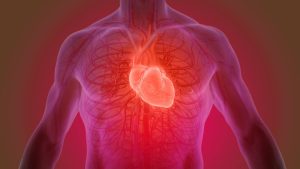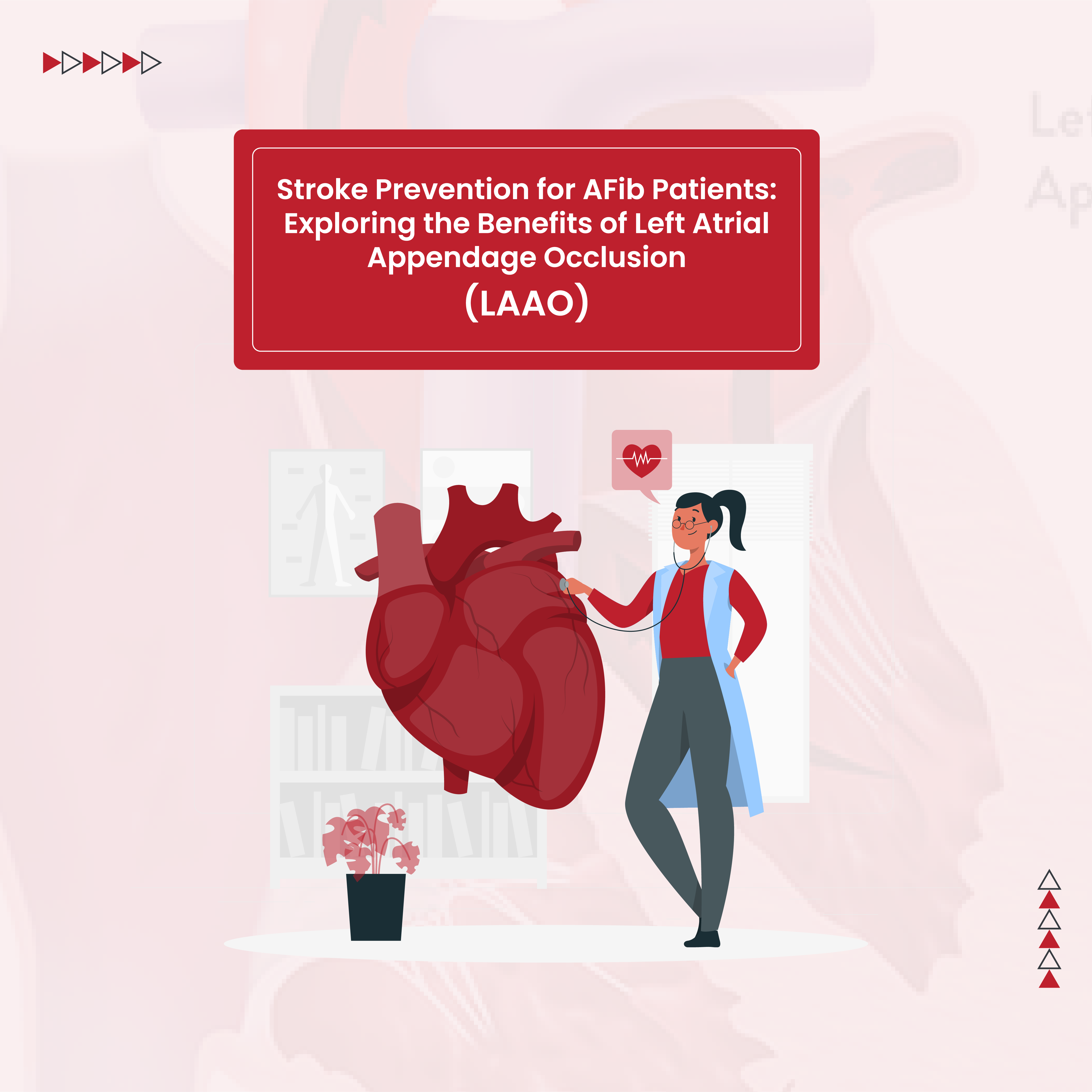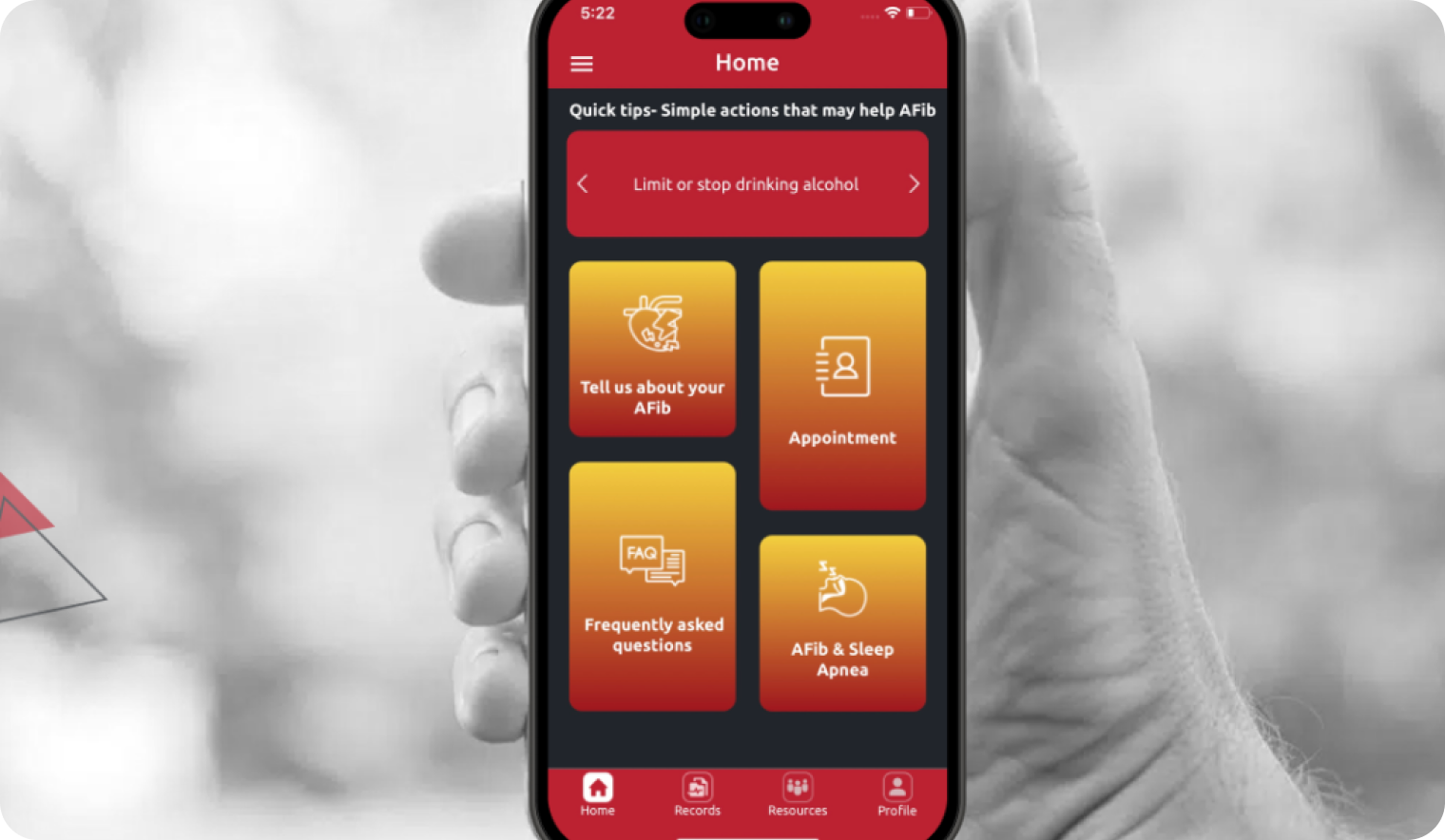Atrial fibrillation is the most common abnormal heart rhythm and increases a person’s risk of stroke and heart failure. Atrial fibrillation diagnosis is important because with proper diagnosis and treatment people with atrial fibrillation can live full, active lives. An important part of Afib diagnosis is also the identification and treatment of any underlying treatable conditions which contribute to atrial fibrillation.
Atrial fibrillation can be challenging to diagnose because it may be paroxysmal, which means it comes and goes. The presence of atrial fibrillation should be considered in patients with high blood pressure, heart failure, valvular heart disease, and/or sleep apnea. Likewise, a person with atrial fibrillation should be evaluated and treated for these conditions, if they are present.
Atrial fibrillation can be silent and not cause any symptoms. Usually though, a person with AFib has at least some symptoms. Common symptoms include chest pain, shortness of breath, palpitations, fatigue, and heart fluttering. The presence of a combination of these symptoms can start the process which ultimately leads to AFib diagnosis. If a person is suspected of having atrial fibrillation, lab tests, an electrocardiogram and other imaging or diagnostic studies will be necessary to help diagnose AFib and guide treatment.
How is AFib detected?
Atrial fibrillation causes an irregular pulse, which can be detected on a physical exam. However, atrial fibrillation is not the only abnormal heart rhythm which causes an irregular pulse. Therefore if an irregular pulse is noted, further testing would be needed to diagnose AFib. Atrial fibrillation is a rhythm disorder so definitive diagnosis of AFib relies on tests which evaluate the heart’s electrical conduction such as an electrocardiogram or cardiac monitor.
Using an electrocardiogram to diagnose AFib
An electrocardiogram (EKG) captures and creates a tracing of the heart’s electrical activity. When the heart is in a normal rhythm the rate is regular and each beat originates in the sinus node (heart’s intrinsic pacemaker). The electrical impulse spreads from the sinus node across the upper chambers of the heart (atria) and causes them to contract. The electrical signal also travels from the sinus node to the AV node. After the impulse passes through the AV node, it spreads down through the ventricles which causes them to contract and push blood from the heart to the lungs and the rest of the body. The heart then goes into a refractory (rest) period and the muscle cells reset to become ready to receive the next electrical impulse. Each of these cycles causes one heartbeat. All of this information is captured on an electrocardiogram. The normal cardiac cycle (heart beat) described above creates a typical and regular pattern on electrocardiogram. Different heart rhythms create different electrical tracings on an electrocardiogram.
What does atrial fibrillation look like on an electrocardiogram?
The chaotic rhythm of atrial fibrillation has a characteristic appearance on electrocardiogram and is irregularly irregular. In patients with atrial fibrillation, rather than regular, organized electrical activity on the electrocardiogram it will show numerous, disorganized electrical impulses originating in the atria and an irregular ventricular rhythm.
The AV node and AFib
The rhythm is irregular because the AV node, which acts as an gatekeeper between the atria and ventricles, only allows some of the erratic atrial signals through to the ventricles. This is an important safety measure because if all of the atrial impulses were allowed through the AV node, a person in atrial fibrillation could have a heart rate as high as 250-300 beats per minute which would not be sustainable.
Why does the heart rate go high in atrial fibrillation?
Even with the AV node effectively filtering out many of the atrial signals, it is common for a person diagnosed with atrial fibrillation to have a heart rate higher than the normal 60 to 100 beats per minute. People with AFib usually become symptomatic with these elevated heart rates especially when the rate is greater than 120 beats per minute.
How is heart rate controlled in AFib?
Controlling the rate of atrial fibrillation is very important because an uncontrolled, elevated heart rate puts additional stress on the heart and increases the risk of AFib complications, such as heart failure. Rate controlling medications such as calcium channel blockers and beta blockers are commonly used in people with AFib. In addition to decreasing the risk of AFib complications, maintaining a normal heart rate often helps people with atrial fibrillation have fewer or less severe AFib related symptoms.
Afib diagnosis using cardiac monitors
Atrial fibrillation may not be present all the time, as is seen with paroxysmal AFib. With paroxysmal AFib, a person will have periods of atrial fibrillation and periods of normal rhythm. Paroxysmal atrial fibrillation may be challenging to diagnose by electrocardiogram because it comes and goes.Therefore, it is possible that the electrocardiogram will be completely normal if it is done during a period when a person is not in atrial fibrillation.
For example, Bill is a 65-year old male who goes to his doctor because he had a couple episodes of palpitations and shortness of breath. The first episode occurred last week while he was playing pickleball. The symptoms went away after he was done with his game and he attributed them to being out of shape. But then he had another episode yesterday. This one occurred while he was watching television and lasted for 45 minutes. He considered going to the emergency room but just as he was getting ready to ask his wife to drive him to the hospital, the symptoms resolved. He reports that he feels fine today. The doctor orders an electrocardiogram which shows normal rhythm with a heart rate of 65 beats per minute. Routine atrial fibrillation labs are checked and are all normal. Chest xray is also normal. Bill’s doctor is concerned because his symptoms are consistent with atrial fibrillation or other abnormal heart rhythm. Since the electrocardiogram was normal today, it raises the likelihood of paroxysmal atrial fibrillation. In cases like these, an extended cardiac monitor is an excellent option.
An extended, ambulatory cardiac monitor can be worn for 24 hours to 30 days. The device monitors for abnormal electrical activity in the heart. Bill’s doctor orders a 30 day monitor which does not show any atrial fibrillation. His doctor reassures him and tells Bill to call if his symptoms recur. Bill goes home and is doing great but three months later, he has another episode of palpitations, shortness of breath and fatigue. This episode occurs while he is eating dinner and lasts for about 30 minutes. Bill sees his doctor for follow-up the following day. Once again his electrocardiogram is normal. In situations like this, an implantable cardiac monitor may be helpful in diagnosing atrial fibrillation.
How do you detect AFib that does not occur very often?
An implantable cardiac monitor (loop recorder) is a small device which is implanted under the skin on the chest, just to the left of the breastbone (sternum). It can stay in place for up to three years. It is an option for the diagnosis of AFib especially for a person, like Bill, who has infrequent symptoms.
Common atrial fibrillation lab tests
When atrial fibrillation is suspected certain lab and diagnostic tests are recommended. Lab tests (blood work) do not diagnose atrial fibrillation but are an important part of atrial fibrillation diagnosis because they can help identify a treatable underlying condition that is causing the AFib. For example, thyroid function will be checked with lab tests because an overactive thyroid (hyperthyroidism) can cause atrial fibrillation. In addition, electrolytes will be checked because abnormalities such as low potassium or magnesium can cause AFib. Kidney problems and anemia can also contribute to atrial fibrillation so labs will be done to evaluate these as well.
Can AFib be detected by echocardiogram?
An echocardiogram uses high-frequency sound waves (ultrasound) to make moving images of the heart. This ultrasound allows healthcare providers to evaluate the structure and function of the heart and is recommended in the assessment and diagnosis of atrial fibrillation. While the diagnosis of atrial fibrillation is confirmed with electrocardiogram, an echocardiogram allows for assessment of the cardiac effects of atrial fibrillation. It also helps identify possible underlying causes for the atrial fibrillation, such as structural problems like valvular disease, heart failure or congenital heart disease.
Transthoracic Echocardiogram
There are different types of echocardiograms. A transthoracic echocardiogram is the most common. During a transthoracic echocardiogram, an ultrasound probe is placed on the chest wall and images are obtained. This type of echocardiogram provides an excellent overview of the heart’s structure and function. Over time AFib’s chaotic electrical activity can cause enlargement and stiffening of the atria, particularly the left atrium. There can also be changes in the size and function of the ventricles. Heart failure is when the ventricles ability to effectively pump blood out of the heart is decreased. One of the major complications of atrial fibrillation is heart failure.
Transesophageal Echocardiogram
Another major complication of atrial fibrillation is stroke. The erratic electrical activity in the left atrium can cause blood to pool in the left atrial appendage. The left atrial appendage is a small fingerlike structure which hangs off the left atrium. AFib can cause blood pooling and incomplete emptying of the left atrial appendage which leads to blood clots. If these blood clots migrate out of the heart they can go to the brain and cause a stroke. Patients with atrial fibrillation have a 5 times greater risk of stroke compared to the general population. It is difficult to assess the left atrial appendage using a transthoracic echocardiogram. A transesophageal echocardiogram allows for much better imaging of the left atrial appendage. During a transesophageal echocardiogram, the patient is sedated and the ultrasound probe is passed into the esophagus. The esophagus passes right behind the heart so placing the probe in the esophagus allows for improved imaging of the left atrial appendage and certain valves because the probe is physically closer to the heart. The transesophageal echocardiogram is also able to view the heart from different angles than the transthoracic echocardiogram. The information provided by a transesophageal echocardiogram is used for pre-procedure planning for atrial fibrillation procedures such as cardioversion, catheter ablation, and the surgical MAZE procedure.
Intracardiac Echocardiogram
An intracardiac echocardiogram is used during some atrial fibrillation procedures, such as a catheter ablation and left atrial appendage closure. This allows for very precise cardiac imaging throughout the procedure.

What are the warning signs of AFib?
Symptoms of atrial fibrillation include racing heart, skipped beats (palpitations), fluttering sensation in the chest, shortness of breath, chest pain, fatigue or decreased exercise capacity. People with atrial fibrillation often have one or more of these symptoms, although some people with AFib have no symptoms at all. Some people can tell the instant they go into atrial fibrillation and know exactly how long each episode lasts because their symptoms are very pronounced.
Do people with atrial fibrillation always have symptoms?
Some people with AFib do not have symptoms while others do not necessarily recognize the symptoms of atrial fibrillation right away. This can be especially true if someone is in persistent atrial fibrillation. For example, Maria is a 72-year old female who is found to have an irregular pulse when she sees her doctor for her annual exam. She reports that she has been feeling well. She denies shortness of breath, palpitations, chest pain, fatigue, or decreased exercise tolerance. She has a history of high blood pressure and diabetes and takes all of her medications as prescribed. Given her irregular pulse, her doctor orders an electrocardiogram which shows atrial fibrillation with heart rate 105 beats per minute. She does not have a known history of atrial fibrillation. Her doctor orders atrial fibrillation labs and an echocardiogram. She also starts Maria on a calcium channel blocker to slow her heart rate down and a blood thinner to lower her risk of stroke. Her echocardiogram shows some structural changes and signs of heart strain that are consistent with the atrial fibrillation having been present for some time. Ultimately, Maria is referred to a cardiologist who recommends a cardioversion to try to get her back into a normal rhythm. Maria continues to deny any symptoms associated with her atrial fibrillation. She does comment that she used to care for her grandchildren but no longer has energy for this over the past 6 months. She attributes this to her age and the grandchildren being ‘very rambunctious.’ She undergoes cardioversion and is successfully converted to a normal rhythm. When she sees her cardiologist in follow-up a few weeks later, an electrocardiogram shows that she is still in a normal rhythm. She is happy to report that her energy since the cardioversion is better than it was before. She has even had the energy to babysit her grandchildren a few times since the cardioversion.
This is not an uncommon scenario especially amongst older patients with persistent atrial fibrillation who are not especially active. The body has amazing abilities to adapt and some people with atrial fibrillation have subtle enough symptoms from atrial fibrillation that they attribute the fatigue or shortness of breath to age or ‘being out of shape.’ Similar to Maria, sometimes people are not able to identify atrial fibrillation symptoms until they are back in a normal rhythm. Ideally, once the symptoms are identified a person will be better able to detect future episodes of atrial fibrillation.
What triggers atrial fibrillation?
Changes to the heart’s structure and function can trigger atrial fibrillation. Some things which cause these changes are due to genetics or may be secondary to a condition a person is born with such a congenital heart disease. In these cases, there may not be a lot a person can do to change their AFib risk. However, there are a variety of modifiable medical and lifestyle risk factors for atrial fibrillation. Medical conditions such as high blood pressure, heart failure, valvular heart disease, diabetes, obesity, sleep apnea, coronary artery disease and kidney failure can all lead to atrial fibrillation. Lifestyle risk factors for atrial fibrillation include alcohol, certain drugs (i.e. cocaine), and the extremes of physical activity can be triggers for atrial fibrillation. A person with more of these modifiable risk factors will have a greater chance of developing atrial fibrillation.
What should you not do if you have atrial fibrillation?
There are a number of things a person with atrial fibrillation can do to positively impact the course of their AFib and thus affect their long term outcomes. Leading a healthy lifestyle has direct and indirect effects which helps minimize atrial fibrillation. Some AFib risk factors are compounded, meaning that they increase the risk of atrial fibrillation and they also increase the risk of other AFib risk factors. For example, obesity is an independent risk factor for atrial fibrillation but it also increases the risk of high blood pressure, sleep apnea, and diabetes which all also increase the risk of developing atrial fibrillation.
Does obesity make AFib worse?
Maintaining an ideal body weight has many health benefits. This is also true for atrial fibrillation. For example, people who are obese are almost 30% more likley to have atrial fibrillation compared to those who are overweight. Weight gain also makes it more likely for atrial fibrillation to progress from being paroxysmal to persistent or permanent. Weight loss is beneficial for people with AFib. In 2015, a longitudinal study was published which detailed the benefits of sustained weight loss for participants with obesity and atrial fibrillation. In this study, 45% of people who lost and maintained 10% weight loss over 4 years achieved freedom from AFib without the need for medications or procedures. This is in contrast to the participants who lost less than 3% body weight. In this group only 13% became AFib free without medication or procedures. A different study showed that 88% of participants who lost 10% of their body weight went from having persistent atrial fibrillation to having either paroxysmal AFib or actually becoming AFib free.
Avoid drinking too much alcohol
Alcohol is irritating to the heart’s electrical conduction system and excessive alcohol use can cause AFib. It can also cause electrolyte abnormalities which can trigger atrial fibrillation. If a person with atrial fibrillation is going to drink alcohol, it is recommended that women drink no more than 1 drink per day and men drink no more than 2 drinks per day. A standard drink is 5 oz. of wine, 1.5 oz. of hard alcohol (vodka, whiskey, etc.), and 12 oz. or regular beer. Many people choose not to drink any alcohol during the week and only drink on the weekends. Some people make this choice because they think it is healthier. In terms of atrial fibrillation, this pattern can actually be more harmful because binge drinking is especially problematic for people with atrial fibrillation. For example, there are two females with atrial fibrillation who both drink a total of 7 alcoholic drinks per week. One of the women has one 5 oz. glass of wine per night. The other woman does not drink anything during the week but on the weekends will have 3-4 beers on both Friday and Saturday nights. Each of these women are drinking roughly the same amount of alcohol per week. However, the woman who drinks all of her alcohol over the course of 2 days is more likely to have her atrial fibrillation triggered by alcohol than the woman who spreads the alcohol out over the week. Another common occurrence is for people to drink significantly more alcohol than usual when on vacation or around the holidays which can inadvertently trigger AFib. Moderation is important for all people but this is especially true for people with atrial fibrillation.
Do not exercise too much or too little
Physical activity is another area where moderation is important. Moderate physical activity for approximately 150 minutes per week is recommended for most people and can decrease the risk of atrial fibrillation. Research has shown that people who engage in moderate physical activity have less atrial fibrillation when compared to a similar group of people who are sedentary. Regular, moderate exercise not only decreases the risk of atrial fibrillation, it also decreases the incidence of high blood pressure, obesity, and diabetes. A sedentary lifestyle increases the risk of atrial fibrillation and so does extreme exercise. For example, people who engage in ultramarathons may have a higher risk of atrial fibrillation. This seems to be especially true for people who engage in endurance sports at higher altitudes.
Don’t stress
Physical or emotional stress triggers the body’s fight or flight response and increases the release of stress hormones like adrenaline and cortisol. These hormones are very beneficial in the short term and cause changes which are important for survival such as with our ancestors who needed to react quickly to escape being eaten by a tiger. However, exposure to these hormones over a sustained period of time causes damage which can lead to structural and electrical changes in the heart. These changes can increase the risk of atrial fibrillation. Stress management tools such as yoga, Tai Chi and meditation can decrease levels of these hormones and put the body in a more harmonious, restorative state. The benefit of acupuncture for AFib is also being studied and preliminary results are promising.
Treat underlying conditions that contribute to AFib
Adequately treating underlying conditions such as sleep apnea, diabetes, heart failure and high blood pressure decreases atrial fibrillation. For example, a person with untreated sleep apnea will get less benefit from atrial fibrillation medications and procedures. Likewise a person with heart failure is more likely to have more atrial fibrillation as the heart failure worsens. This is especially problematic because a heart weakened by heart failure is less able to tolerate atrial fibrillation and the person is therefore more likely to have heart failure complications such as water retention and worsening symptoms.
Take medications as prescribed
Atrial fibrillation increases the risk of heart failure and stroke. It is important for people with AFib to do all they can to modify their lifestyle to decrease the incidence of atrial fibrillation and the diseases which contribute to atrial fibrillation. For most people, medications will be necessary to treat the atrial fibrillation and reduce risk of stroke. This will often include medications to treat the rhythm, control the rate and thin the blood to prevent blood clots which can cause a stroke. Medications such as antiarrhythmics, calcium channel blockers, beta blockers and blood thinners all have potential side effects and it is very important to take these medications as prescribed. If a treatment regimen is too complex or is not working for your lifestyle, talk with your healthcare provider. There are many effective options available for treating atrial fibrillation. Tell us your concerns, or review your wearable rhythm strip results with one of our specialists. Schedule a FREE Consultation Today.








